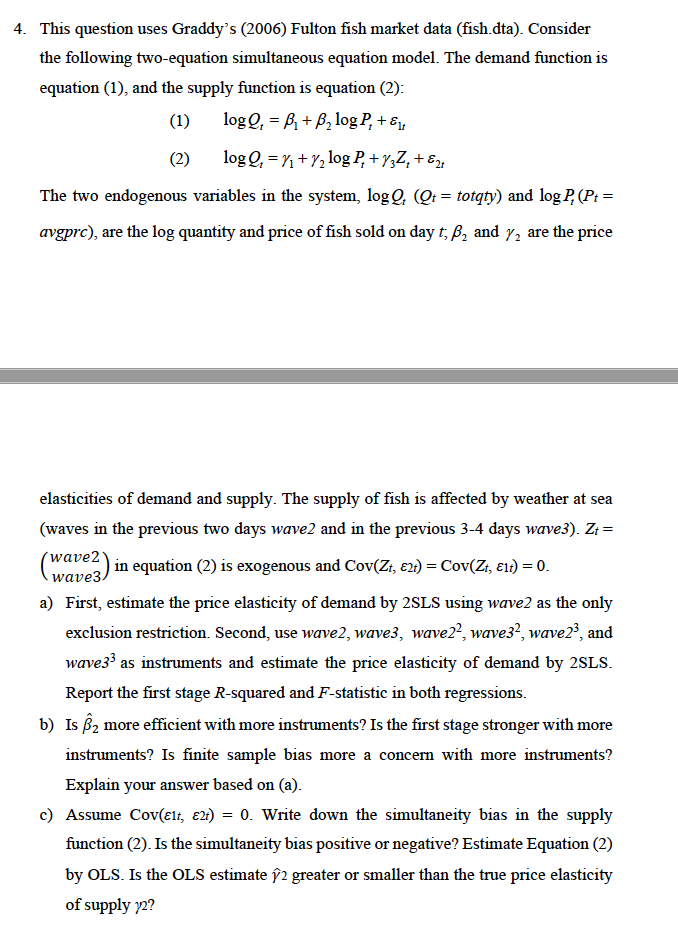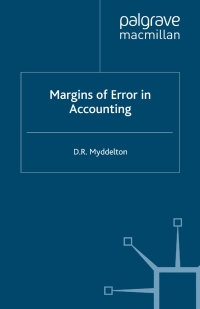
4. This question uses Graddy's (2006) Fulton fish market data (fish.dta). Consider the following two-equation simultaneous equation model. The demand function is equation (1), and the supply function is equation (2): (1) logQt=1+2logPt+1t (2) logQt=1+2logPt+3Zt+2t The two endogenous variables in the system, logQt(Qt= totqty ) and logPt(Pt= avgprc), are the log quantity and price of fish sold on day t;2 and 2 are the price elasticities of demand and supply. The supply of fish is affected by weather at sea (waves in the previous two days wave 2 and in the previous 3-4 days wave 3). Zt= (wave2wave3) in equation (2) is exogenous and Cov(Zt,2t)=Cov(Zt,1t)=0. a) First, estimate the price elasticity of demand by 2 SLS using wave 2 as the only exclusion restriction. Second, use wave 2 , wave 3 , wave 22, wave 32, wave 23, and wave 33 as instruments and estimate the price elasticity of demand by 2SLS. Report the first stage R-squared and F-statistic in both regressions. b) Is ^2 more efficient with more instruments? Is the first stage stronger with more instruments? Is finite sample bias more a concern with more instruments? Explain your answer based on (a). c) Assume Cov(1t,2t)=0. Write down the simultaneity bias in the supply function (2). Is the simultaneity bias positive or negative? Estimate Equation (2) by OLS. Is the OLS estimate ^2 greater or smaller than the true price elasticity of supply 2 ? 4. This question uses Graddy's (2006) Fulton fish market data (fish.dta). Consider the following two-equation simultaneous equation model. The demand function is equation (1), and the supply function is equation (2): (1) logQt=1+2logPt+1t (2) logQt=1+2logPt+3Zt+2t The two endogenous variables in the system, logQt(Qt= totqty ) and logPt(Pt= avgprc), are the log quantity and price of fish sold on day t;2 and 2 are the price elasticities of demand and supply. The supply of fish is affected by weather at sea (waves in the previous two days wave 2 and in the previous 3-4 days wave 3). Zt= (wave2wave3) in equation (2) is exogenous and Cov(Zt,2t)=Cov(Zt,1t)=0. a) First, estimate the price elasticity of demand by 2 SLS using wave 2 as the only exclusion restriction. Second, use wave 2 , wave 3 , wave 22, wave 32, wave 23, and wave 33 as instruments and estimate the price elasticity of demand by 2SLS. Report the first stage R-squared and F-statistic in both regressions. b) Is ^2 more efficient with more instruments? Is the first stage stronger with more instruments? Is finite sample bias more a concern with more instruments? Explain your answer based on (a). c) Assume Cov(1t,2t)=0. Write down the simultaneity bias in the supply function (2). Is the simultaneity bias positive or negative? Estimate Equation (2) by OLS. Is the OLS estimate ^2 greater or smaller than the true price elasticity of supply 2







